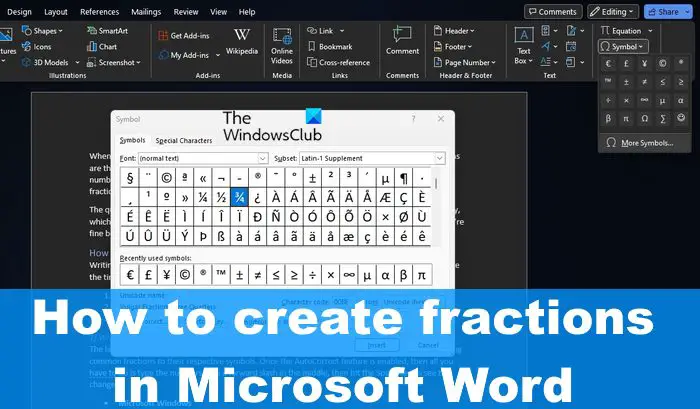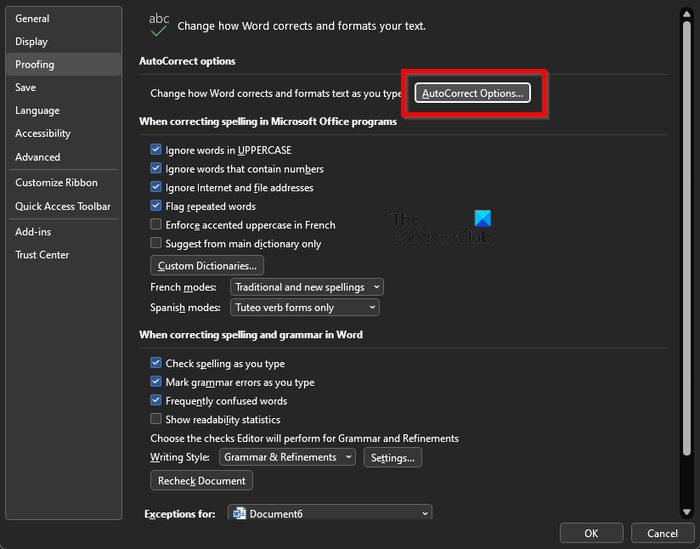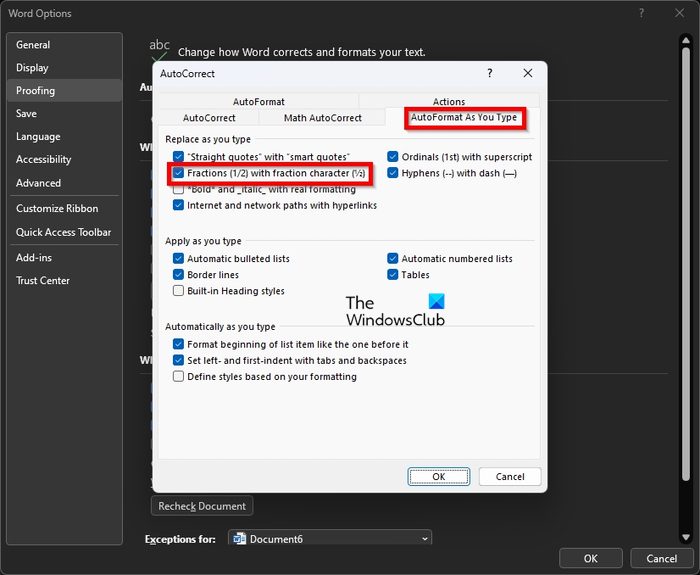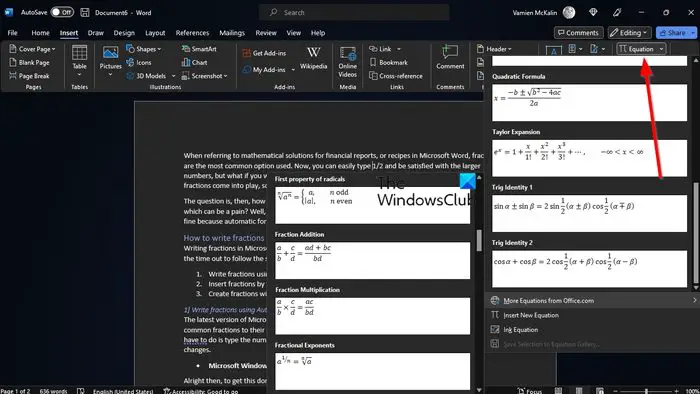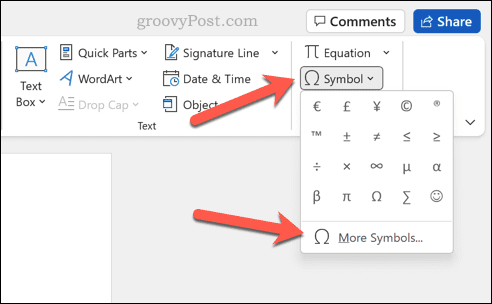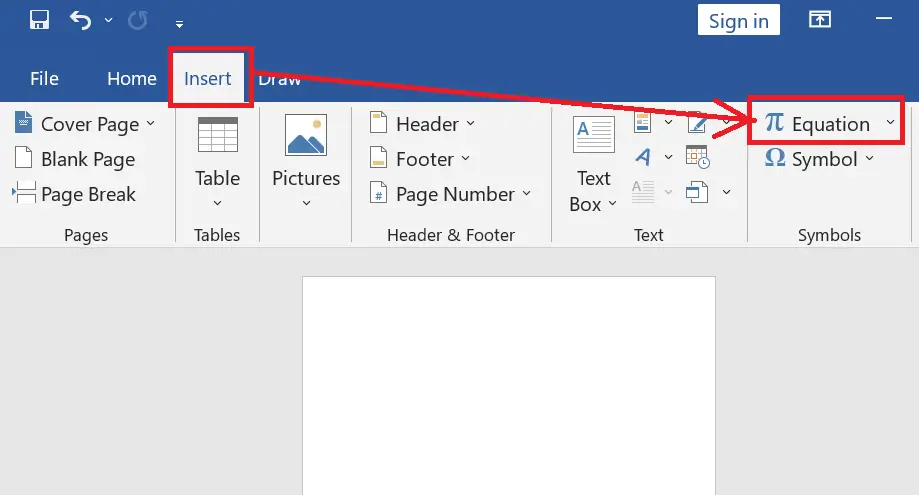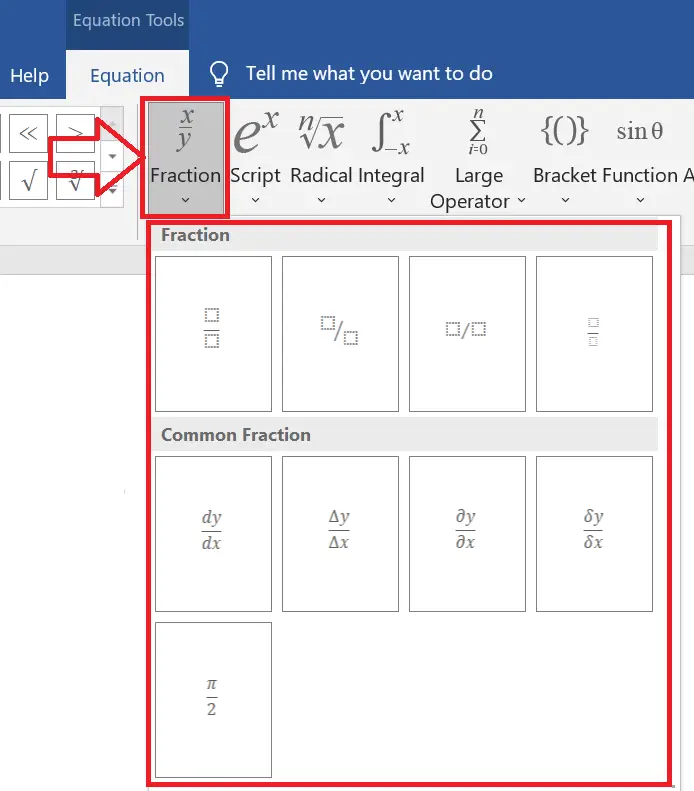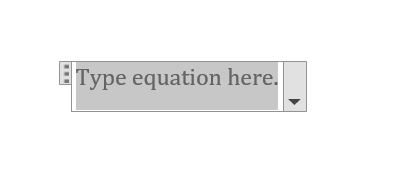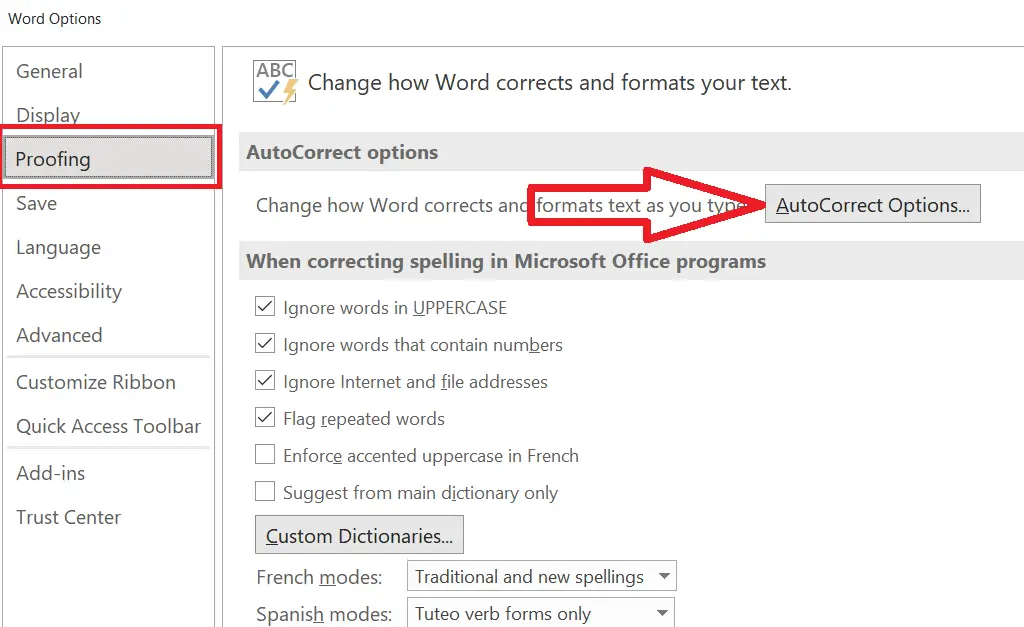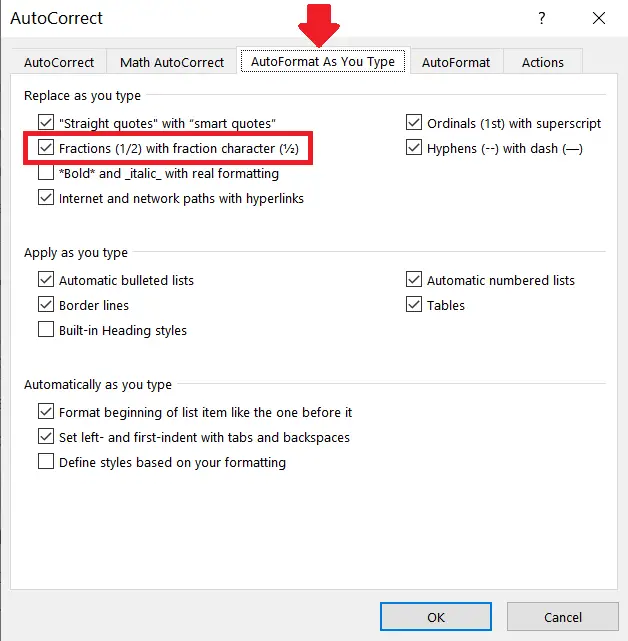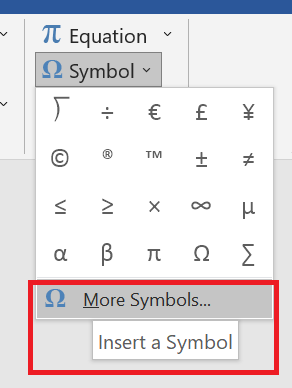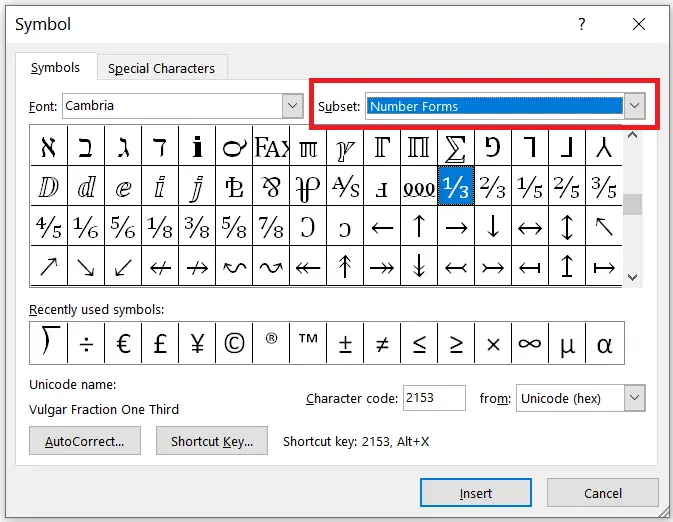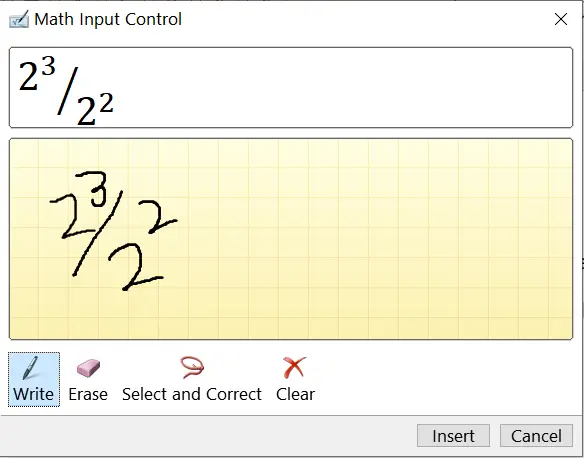Fractions are used in all sorts of writing, from science and math papers to financial reports, and even recipes. But what is the best way to write numeric fractions in Microsoft Word if you want professional results?
In this post, we look at your options, which include:
- Typing fractions as regular text on a single line.
- Using pre-formatted fraction symbols.
- Creating a fraction using the fraction division slash symbol.
- Using the “Equation” tool to create a custom fraction.
We’ll look at how each of these approaches works. Watch the video or read the post below to get started.
Typing Fractions on a Single Line
The simplest way to write fractions in Microsoft Word is to just use a forward slash between the numerator and denominator (i.e., the two numbers that make up a fraction):
Add 2/3 of a cup of buttermilk to the flour mixture.
This will be fine in most cases, especially in less formal writing.
However, some style guides specify using fraction symbols, which tend to look more professional as well. So, what are your options if you want to use pre-formatted fraction symbols in Microsoft Word?
Autoformatting Common Fractions in Microsoft Word
Microsoft Word will automatically format certain fractions (i.e., ¼, ½, ¾) as symbols if you type them in as shown above. For instance, if you type “1/2” in d Microsoft Word document, as long as you have the default autoformatting turned on, it will automatically change to the ½ symbol.
You can turn this feature on or off via the proofing options. To do this:
- Go to File > Options > Proofing (or Word > Preferences in Word for Mac).
- Click AutoCorrect Options and select the AutoFormat As You Type tab (or Authoring and Proofing > AutoCorrect in Word for Mac).
- Check or uncheck the box for fractions under Replace as you type…
- Click OK to save your autocorrect settings.
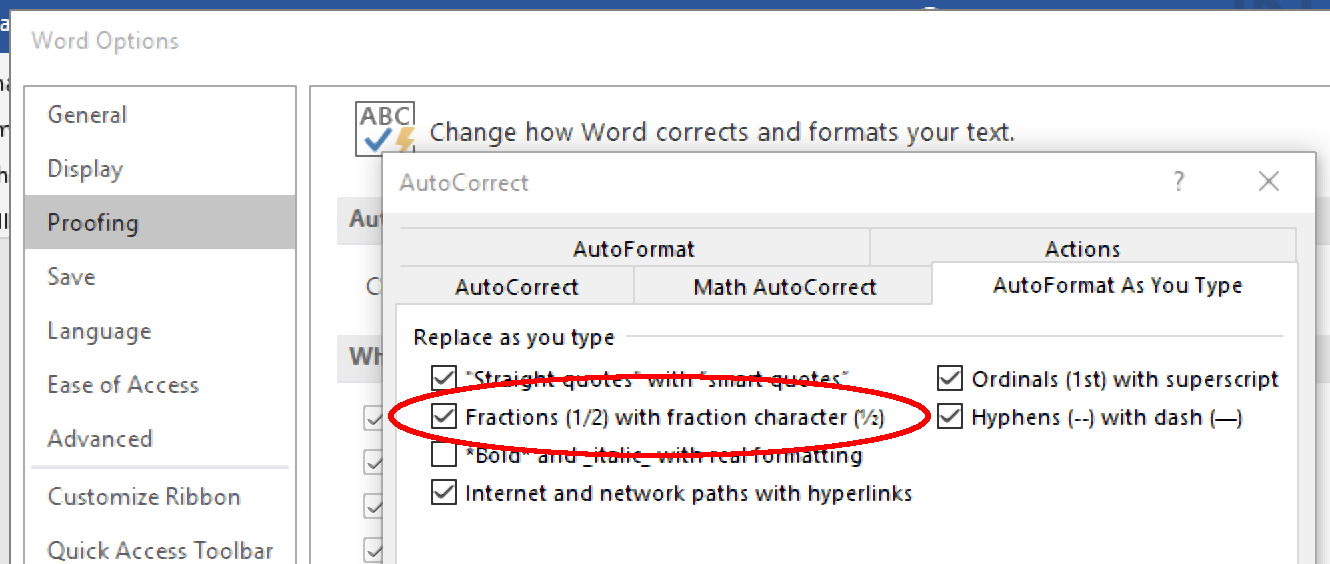
If required, you can even customize autocorrect to use other fraction symbols. We’ll look at how to access these symbols next.
Find this useful?
Subscribe to our newsletter and get writing tips from our editors straight to your inbox.
Accessing Other Fraction Symbols
Microsoft Word for Windows also has pre-formatted symbols for other fractions (e.g., ⅓, ⅔, ⅛, ⅜, ⅝, ⅞). And to access these, you need to:
- Place your cursor where you want to insert the fraction.
- Go to Insert > Symbol > More Symbols.
- In the Subset menu, choose Number Forms.
- Select the fraction you want to use and click Insert.
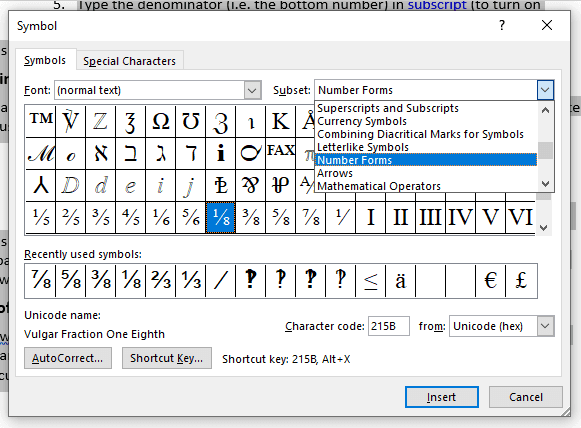
The fraction symbol will then be inserted into the text in the place selected when you close the menu. In addition, the selected symbol will be added to the quick access menu under “Symbols.”
Mac users, meanwhile, can access pre-formatted symbols for other fractions by searching for “fraction” in the character viewer menu.
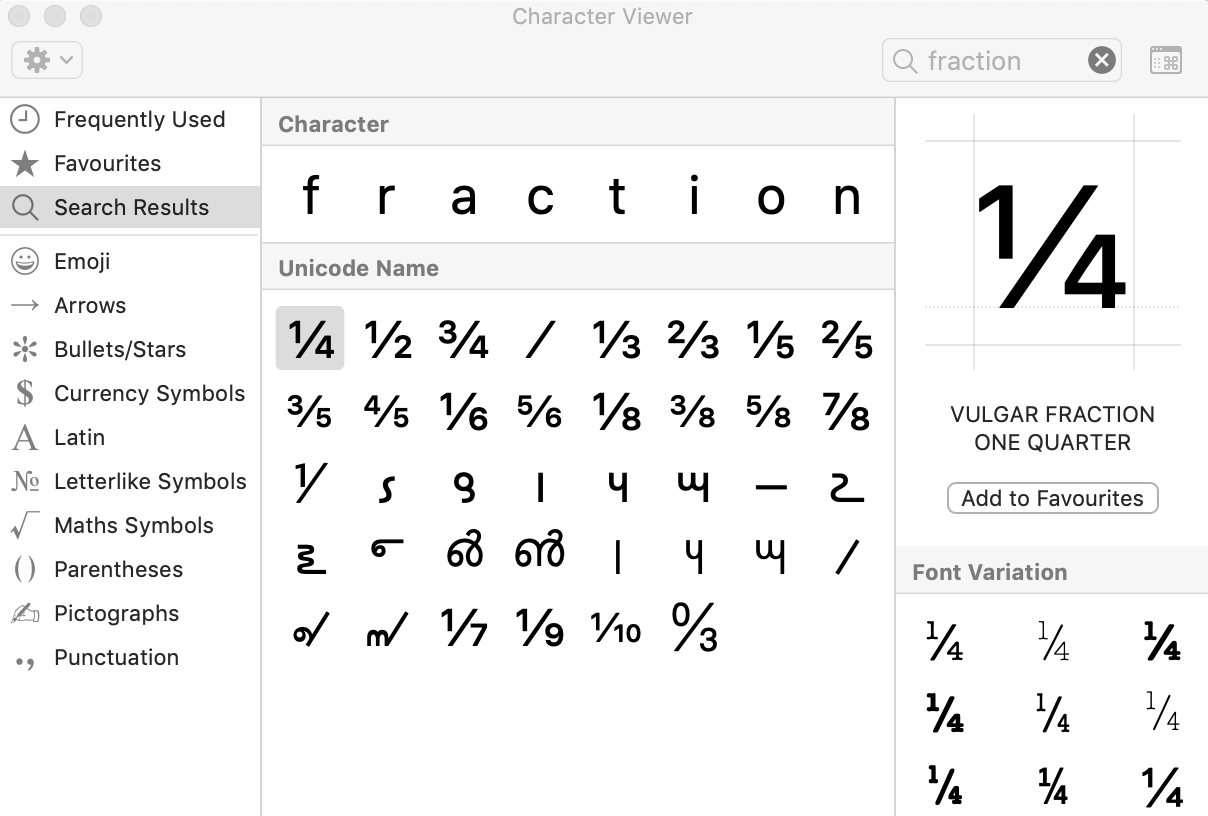
Using the Division Slash to Create Custom Fractions
One way to write custom fractions is to use the division slash ( ∕ ). This is a little different to a regular forward slash, and by formatting the numbers before and after the slash correctly, you end up with a fraction that looks more like the pre-formatted ones above (e.g., 5∕6, 8∕9).
To create a custom fraction like this:
- Place the cursor where you want to insert a fraction.
- Type the numerator (i.e., the top number) in superscript (to turn on superscript, click the X2 button in the Home tab).
- Open the Symbols menu as described above.
- In the Subset menu, choose Number Forms (or Math Symbols in the character viewer on Mac).
- Select the division slash and click Insert to add it your document. Make sure that it is formatted as regular text (not superscript or subscript).
- Type the denominator (i.e., the bottom number) in subscript (to turn on subscript, click the X2 button in the Home tab).
This will give you a numerator∕denominator fraction in the place selected.
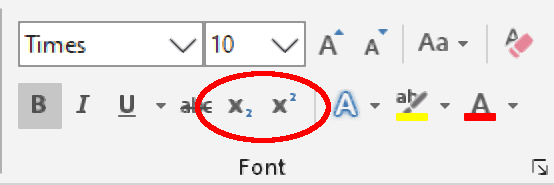
Using the Equation Tool to Add a Fraction
Finally, Microsoft Word also features an “Equation” tool, which includes an option to create a custom fraction. To use this:
- Go to Insert > Equation on the main ribbon.
- Click Equation and select Insert New Equation.
- On the Equation Tools tab, select Fraction and pick a fraction design.
- In the box that appears, add the numerator and denominator.
This is your best option if you’re using a fraction as part of an equation or presenting it separate from the main text in the document. However, equation fields don’t always fit well with surrounding text in other cases.
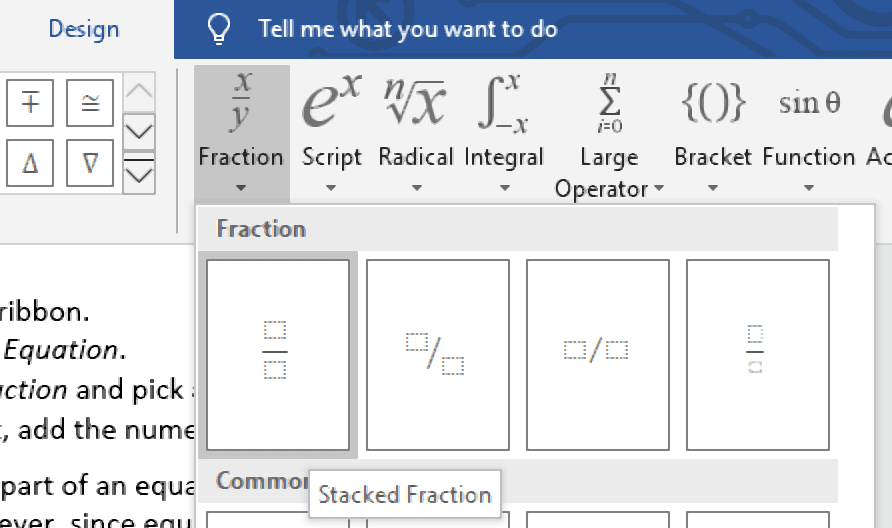
Professional Proofreading Services
However you choose to write fractions in Microsoft Word, you need to make sure they are clear and consistent at all times! And to be extra sure of this, you may want to submit a document to our proofreading services.
- Using the AutoFormat As You Type feature
- Using predefined fractions
- Using the Equation tool
By default, MS Word is configured to use the first method. This feature detects and automatically formats fractions as you type them.
Method 1: Using the AutoFormat As You Type Feature
Step 1: Open Word Document
Step 2: Access the Word Options dialog box.
On the ribbon, click the File tab to display the Start screen.
From there, click the Options button on the bottom left corner to display the Word Options dialog box.
Step 3: Display the AutoCorrect dialog box from the Proofing section.
Click the Proofing section and find the AutoCorrect Options button.
Click it to display the AutoCorrect dialog box.
This dialog box contains features that can automatically format texts as you type them in your document.
Step 4: Enable fraction characters on the AutoFormat As You Type tab.
Click the AutoFormat As You Type tab on the AutoCorrect dialog box.
On this tab, you’ll need to focus on the Replace as you type section.
Check the Fractions (1/2) with fraction character (½) checkbox.
Leave other checkboxes as is and click the OK button of the AutoCorrect dialog to apply your setting.
Step 5: Type fractions in your document.
Now that you have enabled the fraction character feature, you can already type fractions in your document. Recall that there are two parts of a fraction—numerator and denominator.
Type the numerator immediately, followed by the division symbol “/” and the denominator.
Remember not to include spaces between your input characters, for it will not be considered a fraction by the AutoCorrect feature.
After typing your fraction, press the spacebar key on your keyboard and notice that your data will be formatted into a fraction character.
Method 2: Using Predefined Fractions
Another method that you can use to include fractions is by using predefined fractions that are accessible on the Symbol dialog box. .
Step 1: Open the MS Word program.
Step 2: Access the Symbols dialog box.
With a document already open, click the Insert tab on the ribbon and look for the Symbols group.
From here, you need to click the Symbol drop-down button to view the list of symbols under it.
By default, the drop-down list will display the recently-used ones. To access all available symbols, click the More Symbols button under the list.
Step 3: View available fractions under the Number Forms subset.
Now that you have displayed the Symbol dialog box, you need to filter the list of symbols.
Click the Subset drop-down button and choose Number Forms from the list.
MS Word automatically filters the list of symbols based on your condition.
Step 4: Choose the appropriate fraction.
To insert a fraction, click the desired fraction from the dialog box and subsequently, click the Insert button.
Notice that the selected fraction will be inserted automatically to the location of your mouse cursor.
The Symbol dialog box will not close yet to let you insert additional fractions or symbols.
Once you are done, just click the Close button to close the dialog box.
Method 3: Using the Equation Tool
You can also insert fractions to your document using the Equation tool under the Insert tab. Among the tools discussed, this is perhaps the most flexible for it allows you to freely customize the parts of your fraction. It also offers a list of fraction styles you can choose from.
The following are the simple steps on how to utilize it.
Step 1: Create a new or open an existing document.
Step 2: Display the Equation Tools.
This is called the Design tab under Equation Tools.
Click the Insert tab on the ribbon.
Go to the Equation drop-down button from the Symbols group.
Located below the drop-down list is the Insert New Equation button.
Click this button and notice that an equation input box appears on your mouse cursor while the Design tab is added on the ribbon.
Step 3: Insert a fraction format.
Click the Fraction drop-down button from the Structures group under the Design tab.
A list will be displayed under the drop-down button, showing you available styles to choose from.
Click your desired style and it will be inserted to the input box.
Step 4: Customize the fraction.
Now that you have inserted a fraction format, you need to set its numerator and denominator.
Edit the fraction’s numerator by clicking it and typing your required number. Perform the same step on the denominator.
Once done, click anywhere outside the input box to preview your fraction.
If in case you mistyped the digits of your fraction, you can just modify it by redoing this step.
Conclusion
And that’s how you type fractions in MS Word. We hope you found this article helpful!
Microsoft Office 2010 and 2013:
- Place the cursor on the document where you would like to insert a fraction.
- Select “Insert” from the menu.
- Click on Equation in the upper right.
- Select fraction under the Equation Tools option.
- Choose which style fraction you want.
- Insert the numbers into the fraction boxes.
Contents
- 1 How do you make a subscript in a fraction in Word?
- 2 How do you type fractions on a keyboard?
- 3 How do you write fractions on Windows 10?
- 4 What is a fraction in word form?
- 5 What is 1/8 in a fraction?
- 6 What is the Alt code for fractions?
- 7 How do I make fractions?
- 8 How do you write fractions in Word on a Mac?
- 9 How do I type fractions in Microsoft Outlook?
- 10 How do you write two and a half in Word?
- 11 What is another way to write 5 12?
- 12 What is another way to say 3 8?
- 13 How do you make the 1 2 symbol on a Mac?
- 14 What is another way to write 5 2?
- 15 What’s 4.5 as a fraction?
- 16 What is 3/4 divided by 2 in a fraction?
- 17 What is 2/5 as a fraction?
- 18 How do you type PI on a laptop?
- 19 What is the character code for 1 8?
- 20 How do you use Harvey balls in Word?
How do you make a subscript in a fraction in Word?
Select the numerator and format it as Superscript (Ctrl+Shift+= or check the box for Superscript in the Font dialog). Select the denominator and format it as Subscript (Ctrl+= or check the box for Subscript in the Font dialog).
How do you type fractions on a keyboard?
Method 1 of 3: Typing Fractions on a PC. Use the division symbol to type a fraction. This may be done by first typing the numerator (the top number of the fraction), the forward slash key ( / ), and the denominator (the bottom number of a fraction).
How do you write fractions on Windows 10?
How do I type fractions
- To switch to a fraction character, click Insert > Symbols > More Symbols.
- In the Subset drop-down list, click Number Forms and select a fraction.
- Click Insert > Close.
What is a fraction in word form?
To express the fraction in words, write the numerator, add a hyphen and then spell out the denominator. In word form, the fraction 3/10 would be spelled out as three-tenths.
What is 1/8 in a fraction?
Decimal and Fraction Conversion Chart
| Fraction | Equivalent Fractions | |
|---|---|---|
| 1/8 | 2/16 | 5/40 |
| 3/8 | 6/16 | 15/40 |
| 5/8 | 10/16 | 25/40 |
| 7/8 | 14/16 | 35/40 |
What is the Alt code for fractions?
List of Alt Codes for entering Mathematical Symbols
| Alt Code | Symbol | Description |
|---|---|---|
| Alt 47 | / | Fraction seperator |
| Alt 0188 | ¼ | Quarter |
| Alt 0189 | ½ | Half |
| Alt 0190 | ¾ | Three quarters |
How do I make fractions?
To use this:
- Go to Insert > Equation on the main ribbon.
- Click Equation and select Insert New Equation.
- On the Equation Tools tab, select Fraction and pick a fraction design.
- In the box that appears, add the numerator and denominator.
How do you write fractions in Word on a Mac?
How to Type Fractions in Microsoft Word & Mac Version
- Click the “Insert” tab in Word and click the “Equation” icon. Video of the Day.
- Click “Fraction” and select the layout of the fraction you want to create.
- Enter the numerator and the denominator of the fraction in the small text boxes that appear.
How do I type fractions in Microsoft Outlook?
To switch to a fraction character, click Insert > Symbols > More Symbols. In the Subset drop-down list, click Number Forms and select a fraction. Click Insert > Close.
How do you write two and a half in Word?
Setting Up AutoFormat for Fractions
- From the OFFICE BUTTON , click WORD OPTIONS. The Word Options dialog box appears.
- From the Categories list, select Proofing.
- Click AUTOCORRECT OPTIONS…
- Select the AutoFormat As You Type tab.
- Select Fractions (1/2) with fraction character (½)
- Click OK.
- Click OK.
What is another way to write 5 12?
Explanation: In order to make 512 into a decimal, you take the top number or numerator, which is 5 , and take your bottom number or your denominator, which is 12 , and divide 5 by 12 . The answer will be 0.416666667 .
What is another way to say 3 8?
Perhaps to further clarify for you, in general, if we say a fraction in common speech, it’s three eighths (or three quarters, or a third, etc.)
How do you make the 1 2 symbol on a Mac?
System Preferences –> Keyboard -> Text (Tab) -> Little ( + ) symbol on the bottom left -> It will create an entry -> Type ( 1/2 ) on the left in the ( Replace ) Column -> Type ( ½ ) on the right in the ( With ) column.
What is another way to write 5 2?
You can write five halves as 5/2.
What’s 4.5 as a fraction?
Every number in decimal form, in which either decimals terminate or certain numbers after decimal point continue to repeat endlessly, can be written as a fraction. As the given number 4.5 terminates after first deciimal it can be written as fraction. Here we have 4.5=4510=92 a fraction.
What is 3/4 divided by 2 in a fraction?
3/8
Answer: 3/4 divided by 2 in the fraction is equal to 3/8. Let us proceed step by step.
What is 2/5 as a fraction?
Decimal to fraction conversion table
| Decimal | Fraction |
|---|---|
| 0.33333333 | 1/3 |
| 0.375 | 3/8 |
| 0.4 | 2/5 |
| 0.42857143 | 3/7 |
How do you type PI on a laptop?
Press ctrl+shift+u then type zero-three-C-zero, then press enter and you get the pi symbol. How do I type the Pi symbol on Windows 10 if I don’t have NUM lock? You don’t need a NUM lock; instead, just hold down the alt key and type 227. The 227 has to be from the keyboard on the right side of your keyboard.
What is the character code for 1 8?
List of characters
| Glyph | Image | Hex |
|---|---|---|
| ⅛ | 1⁄8 | 215B |
| ⅜ | 3⁄8 | 215C |
| ⅝ | 5⁄8 | 215D |
| ⅞ | 7⁄8 | 215E |
How do you use Harvey balls in Word?
To get the Harvey Balls, click in the empty cell in your table and go to the Insert tab. Then find Symbol. Under the font, choose “Segoe UI Symbol”, and under subject find “Geometric Shapes.” There you will find the Harvey Ball options. You can simply hit the insert button here.
When referring to mathematical solutions for financial reports, or recipes in Microsoft Word, fractions are the most common option. Now, you can easily type 1/2 and be satisfied with the larger numbers, but what if you want something more polished and professional? That’s where fractions come into play, so instead of 1/2, it would be ½.
The question is, then, how to automatically format fractions in Word without doing it manually. Well, if you’re using the latest version of Microsoft Word, chances are you’re fine because the automatic formatting of fractions is set to default.
Writing fractions in Microsoft Word is easier than you might think. If you want to learn how then take the time to follow the solutions explained here.
- Write fractions using AutoCorrect
- Insert fractions by means of symbols
- Create fractions with an equation
1] Write fractions using AutoCorrect
The latest version of Microsoft Word on both Windows and Mac is capable of automatically changing common fractions to their respective symbols. Once the AutoCorrect feature is enabled, all you have to do is type the numbers with a forward slash in the middle, then hit the Space key to see the changes.
- Microsoft Windows
To get this done on a Windows operating system, you must first open the Word application.
After that, click on File, then select Options right after.
Click on the Proofing category located on the left panel.
Look for AutoCorrect Option and select it.
Next, you must click the AutoFormat As You Type tab.
Under the Replace as you type section, please tick the box that reads, Fractions (1/2) with fraction character (½).
Finally, click on the OK button to complete this task on a Windows computer.
- Apple Mac
When it comes down to a Mac, you must open Microsoft Word.
Then, please click on Word > Preferences via the menu bar.
Select the option that reads, AutoCorrect.
Click on the tab with the name, AutoFormat As You Type.
Finally, check the box with the text, Fractions With Fraction Character, and that’s it; you’re done.
2] Insert fractions by means of symbols
Here’s the thing, it is possible to write advanced fractions via the AutoCorrect function. At least, it is not possible at the time of writing. You will have to use Special Characters and Letters.
3] Create fractions with an equation
If the above methods are not good enough for you, then using equations is a great way to write fractions. For that you will have to use the Equation Mode in Word.
READ: How to display Numbers as Fractions in Excel
How do you put fractions in Word?
Click in the area where you want to insert the fraction symbol. From there, press the ATL + = buttons to add the Equation tool. Alternatively, you can navigate to the Insert tab, then select the Equation symbol via the Symbols group to reveal the equation gallery. Choose the fraction, and it will be added to the document.
How to make a fraction on a keyboard?
The standard method right now for typing fractions on a keyboard in Word is to enter the numerator and the denominator separated by the / symbol. If the right feature is enabled in Word, then the tool should automatically transform the numbers into proper fractions.
Microsoft Word it is an increasingly complete program after each new version. Among its many capabilities and functionalities, it also allows the insertion of various symbols, as well as the possibility of making all kinds of numerical representations. For example, it is also possible write fractions in Word, although many of its users do not know how to do it. We will explain it to you.
First of all, we must focus on the issue we are talking about. On mathematics, a fraction (or fractional number) expresses a quantity divided by another quantity. Common fractions are made up of a numerator, a denominator, and a dividing line between the two.
Fractions are used in all kinds of writing, from science and math papers but also financial reports o kitchen Recipes. There are several options to write number fractions in Microsoft Word and achieve a professional result. Let’s analyze them one by one:
Write fractions on a single line
This is the easiest way to write fractions in Word. It simply consists of insert the forward slash symbol (/) between the numerator and denominator. That is, between the two numbers that form a fraction. For example, in a kitchen recipe we would see the fraction written as follows: «add 1/4 of a liter of milk to the mixture.»
This method is the most used, as it does not require much effort and in most cases it is sufficient. Especially in less formal writing.
However, this formula will be unprofessional in a more serious text such as a working document or an academic text. Certain style guides specify the mandatory use of fraction symbols. In this case, we have to use the predefined fraction symbols from Microsoft Word.
Automatic self-correction
One of the many new capabilities introduced in the latest versions is to automatically format some of the most used fractions (ie: ¼, ½, ¾). For example, if we write 1/2 as in the previous example, the program will take care of transforming these characters into the ½ symbol.
Word offers us several options to write and represent fractions
To make Word write the fractions in this way, with a much more aesthetic and professional visual result, it is necessary that we have activated the option of «Default auto format». You can enable or disable this feature as follows:
- In the «File» tab, we select «Options».
- There, we choose «Review» and click on «AutoCorrect Options» (or Word> Preferences in Word for Mac).
- The next tab to select is «AutoFormat».
- Finally, we check the box for the fractions in the «replace as you type» list (or Creation and correction> AutoCorrect in Word for Mac).
- Finally, click on «OK» to save the changes in the configuration.
This method is very practical and comfortable. It is the program itself that is responsible for modifying the document as we are writing it. With it, you don’t have to waste time modifying the appearance of the fractions.
Access other fraction symbols
Microsoft Word for Windows also has predefined symbols for expressing other fractions (for example, ⅓, ⅔, ⅛, ⅜, ⅝, ⅞). How to access them?
- In the document, we place the cursor where we want to insert the fraction.
- Next it is done in the tab «Insert» and we select first «Symbol» and then «More symbols».
- In the menu that appears we will «Numerical forms».
- There, in addition to other common mathematical expressions, we select the fraction we want to use and click on «Insert».
For their part, Mac users can access predefined symbols for other fractions by searching for «fraction» in the character viewer menu.
Write fractions in Word with the «Equation» tool
The «Equation» function in Word allows you to write all kinds of mathematical expressions
However, the above system has a clear limitation: it only «transforms» the most common fractions, which we have referred to above. This is clearly insufficient when dealing with the writing of a technical text where more complex fractions appear.
Fortunately, Microsoft offers a definitive solution for these cases: the «Equation» tool, which includes an option to create custom fractions. This tool is used as follows:
- Click on the tab «Insert» and, in the panel that appears, to the right of the screen, we select «Equation».
A new panel opens with several options. The first we find is that of «Insert new equation». - By clicking on it we can choose between different formats. We select the one we want and on the screen that appears we enter the values of the numerator and denominator.
- Once the fraction is defined, press «Enter» and it will be reflected in the document.
The most interesting thing about this tool is that allows you to write almost any type of formula or mathematical expression: not only allows you to write fractions in Word, but also square roots, exponential numbers, integrals, limits and logarithms, matrices, etc. Without a doubt, it is the option that we recommend for professional writing.
The content of the article adheres to our principles of editorial ethics. To report an error click here!.
You don’t need Excel to write fractions in Word, because you can write them directly. This guide will explain how.
You’d think that specialist software like Excel or Google Sheets would be needed to type equations and fractions. You’d be wrong—you can type fractions in Word easily without any other software required.
There are a couple of ways you can do it, from using Word’s auto formatting to inserting special characters. If you’re unsure how to type fractions in Word, follow the steps below.
Using Auto Formatting to Type Fractions in Word
Microsoft Word has a number of features that are designed to help you as you’re typing. One of the most useful is auto formatting. If you type certain words or phrases, Word will automatically correct them to make them right.
Auto formatting will also correct you if you type a fraction by converting it to the matching special character. This makes it extremely easy to type a fraction in Word. If the fraction you want to use isn’t part of the list, you can add it to Word’s auto formatting list.
To do this, open a Word document, type a fraction using a forward slash, and then press the spacebar. For instance, if you type 1/2 in Word, it will automatically convert to the matching special character.
If the fraction doesn’t change automatically, you’ll need to customize your auto formatting (auto correct) dictionary to match the fraction you type (eg. 1/2) to the special character for the fraction it represents.
Using Special Characters to Insert Fractions
If Word’s auto formatting feature doesn’t work to convert fractions for you, you can insert special characters directly. This will allow you to type fractions in Word without concern.
To insert a special character in Microsoft Word:
- Open your Microsoft Word document.
- Place your blinking cursor in the position where you want to insert the fraction symbol.
- On the ribbon bar, press Insert > Symbol > More Symbol.
- In the Symbols window, select Number Forms from the Subset drop-down menu.
- Locate a fraction value that you’re looking for from the list of symbols shown.
- When you locate the fraction you want, double-click it to insert it into the document. Alternatively, select the symbol, then press the Insert button.
- When you’re done, close the Symbols menu.
Repeat this process for any additional fraction symbols, making sure to move your blinking cursor to a new position before you begin. If you’d prefer, you can also type and copy special characters in Windows 11 and insert them into your document directly.
Typing Fractions in Word Easily
Using the steps above, you can quickly type fractions in a Microsoft Word document. If you want to, you can also copy fractions from other software (such as Excel), as long as the numbers are formatted correctly to display as fractions first.
New to Word? There are plenty of Word tips and tricks you should know. For instance, did you know that you could draw in Microsoft Word without using third-party software? You can also edit images in Word using the same drawing tools.
Want to add other forms of content to your Word document? You can easily embed other files into a Word document, including text and images.
If you are a Microsoft Word user then sometimes you require to turn numbers into fractions in the document. Especially when using fractions in word problems. Below are some different ways on how to make a fraction in Word.
There are many ways to write division in fraction form in Word documents. The way to insert a fraction in Word is slightly different from writing fractions in Google Docs. Google Docs is also another Word Processor compared to Microsoft Word.
You can put a diagonal line or a horizontal bar between the numbers (numerator/denominator) which is fraction symbol in Word. Creating fraction in Word is simple and easy.
Open Microsoft Word on your desktop computer.
In the “Menu” bar click to the “Insert” tab then navigate and click to the “Equation” option
When you click the Equation option a new “Equation Tools” tab is visible on the Menu bar. From there click on the “Fraction” option, you will see lots of different types of fraction bar in Word (Stacked Fraction, Skewed Fraction, Linear Fraction).
Select any fraction format from the list, then in the document editor, type your required numerator and denominator. With the equation tool, you can make the mixed fraction, improper fraction in Microsoft Word.
Alternatively, you can also use Alt + = shortcut keys from the keyboard to open the equation box or fraction editor(Type equation here)
How to Insert fraction in Word
To insert fraction in Word follow these steps:
Adjust the automatic change into fraction in Word by adjusting the autocorrect option settings.
First, we see how to set auto format fractions in Microsoft Word
Go to ”File” and click on “Options” to open the Word Options dialog box. Navigate to the “Proofing” tab and select the “AutoCorrect Options”. See below screenshot
Under AutoCorrect box click on the “AutoFormat As You Type” tab and check the box “Fraction(1/2) with fraction character(½)” and click OK to save the settings.
Now when you type the numbers with the diagonal fraction bar with help of the keyboard, it will change automatically.
Some fractions like (1/2, 1/4, and 3/4) automatically switch to a (½, ¼, ¾) fraction symbol in Word but not all of them. For that, we will use the Symbol option, that our next method-
Making fractions in Word with help of Symbols
You can make other preformatted fractions in Word with help of symbols. Follow the below steps-
In the “Menu” bar click on “Insert” tab then navigate to “Symbol” option and click “More Symbols”
You will have a Symbol box that contains lots of different symbols and Special Characters. Under the “Subset” select “Number Forms” to get other preformatted fractions lists like ⅘, ⅙, ⅚, ⅝.
How to type fractions in Word
To type fractions in Word without interrupting your continuous typing then use Ink Equation in Microsoft Word.
Open Microsoft Word and place the cursor where you want to insert fractions.
In the “Menu” bar click on the “Insert” option then click the “Equation” drop-down arrow, go to “lnk Equation” editor.
Now make a rough drawing on the “Math Input Control” box. See the below screenshot.
Now click the Insert button to type a fraction in Word document. With this method, you can easily put the fraction that you find difficult in inserting.
These are the best different ways to write a fraction in Microsoft Word documents, but if still not finding the right fraction format in Word then simply copy and paste the fraction in your document from the Internet.
You might have noticed some times Microsoft Word automatically converts text into required fraction you need. But for most of the case, Word doesn’t do this magical conversion.
It happens because, Ms Word has autocorrect feature enabled by default that convert commonly used fractions like 1/2, 1/4 and 3/4 to fraction characters like ,
and
. However using this feature you can convert only a handful of fraction automatically. It doesn’t work on many other fractions (like 1/5, 2/7 and 3/8). Following method will not only help in writing fraction in Word but also help in writing mathematical equations too.
Then how to convert any fraction into wonderful looking fraction characters?
Shortcut for typing fraction in Word
The trick here is to use Equation Editor for typing fraction in Word. It may sound like quite a task, but believe me if you know correct shortcut then it becomes a piece of cake.
Although you can get equation editor by going to Insert Tab and clicking on Equation, it is an unproductive way of getting it if you need it often.
A study suggests that over 87% of Ms Word users hate switching between keyboard and mouse. And over 75% users prefer to learn keyboard shortcut for doing common task.
Shortcut of Equation Editor
You can get Equation Editor using <Alt> + <=> key simultaneously. If you type it after text in paragraph, it inserts equation editor in next to the text (Inline mode). However when, you press equation editor shortcut on a new line, it places it in the center of the line (new line mode). Ms Word is intelligent enough to understand inline mode and a new line mode of equation editor.
Equation Editor Shorcut for Fraction
After getting equation editor, typing fraction is very easy. Math Autocorrect feature of Ms Word brings latex type functionality in Ms Word. In fact, typing fraction in Ms Word is easier than typing fraction in LaTeX.
Equation Editor of Microsoft Word converts all fractions into fraction characters as soon as you hit space. In-fact hitting space bar inside equation editor triggers Math Autocorrect correction. Following table shows how to type simple and complicated fraction in Word.
| Fraction | Equation Editor Shortcut | Description |
|---|---|---|
| 3/7[sp] | [sp] stands for spacebar. Hitting space bar triggers equation editor to apply Math Autocorrect Shortcut. | |
| (3/7)[sp] | Placing braces around fraction | |
| 1/(1+1/x)[sp] | Nested Fraction |
Conclusion
Math Autocorrect feature of Ms Word makes typing fraction in Word is simple and easy. In-fact, after knowing these shortcut, anyone will prefer Ms Word over LaTeX for typing simple or any complicated fraction.













